Hiking vs Trekking — What’s the difference?
Jargon gets confusing, especially if you’re looking to start hiking or trekking. In this trekking vs hiking face-off, we’ll take a look at the key differences to help you decide which activity suits you best.
It’s plain to see why there is confusion between the two. We have an abundance of information readily available at our fingertips. So maybe you popped in a quick search about hiking vs trekking and you start seeing very close similarities. What gives? Is there a difference between hiking and trekking?
To better understand the differences between hiking and trekking, let’s park apart each activity and get a clear definition.
What’s The Difference Between Hiking and Trekking?
To clear things up a bit, trekking is also used as a synonym for hiking. However, for many, the differences are great enough to break them up into two different activities.
Trekking, according to the conventional outdoors aficionado, is a more physically-demanding and time-consuming sport.
On the flip side, hiking is less demanding than trekking. Though, you can take on some hikes that leave you battered and ready for bed, so don’t let that be a determining factor for what you choose.
With either activity, you’ll definitely be exerting physical effort that requires an energy surplus. Always make sure you pack the right foods and needed amounts of water for your journey.
What is Hiking?
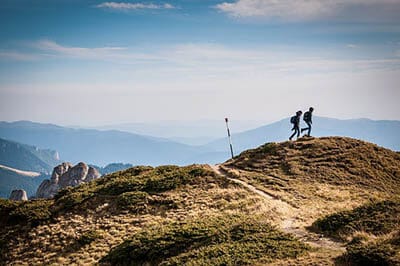
Hiking involves navigating the terrain of various inclines for a day or a half-day.
The difficulty level for hiking is considered easy to mildly challenging, and can usually be completed without a surplus of gear.
Going for a hike will involve visiting a state park or trail and navigating through marked paths to take in the scenery.
While both hiking and trekking are done in groups, hiking can easily be completed alone. It’s also very common to run into other hikers fairly often on a hike. (Related: Hiking Etiquette For Beginners — What Are The Rules of Hiking?)
Physical strain is still a factor. However, hiking isn’t known to be completely exhausting, unless you’ve chosen a difficult trail.
Just because hiking isn’t usually viewed as a massive effort when compared to mountaineering, you should still make sure you’re picking the best snacks for a day hike. It’s also vital to know how much water you need for a day hike.
What Gear Is Used For Hiking?

Hiking gear can be very similar to trekking gear. On the other hand, packing for a hike will usually require far less gear than that needed for a trek.
To keep things simple, let’s take a look at what gear is used for hiking:
- Hiking Boots/Shoes
- Lightweight Backpack
- Hiking Pants
- Properly layered shirts depending on the weather
- Gaiters if you plan on going through tall grass or brush
- Hiking Sticks/Trekking Poles (optional)
- Basic food supplies like hiking snacks
- Water
- GPS is not required, but it comes in handy if you don’t have a map
- Water Purification System — Not required, but a good choice if you plan on hiking near creeks and bodies of water and want to save space in your backpack
Because hikes can vary in length, gear will vary, too.
Weather conditions also affect how much and what kind of gear is used. But prepping for a day-long hike involves less gear prep than, say, a two or three-day trek does.
What Terrain is Involved In Hiking?
The terrain for hiking is usually pretty mild in intensity.
The most common terrain for a hike is naturally made or man-made trails that have been refined and properly marked for hikers.
Hiking trails usually do have hills and some occasionally steep inclines, but they’re not as intense as, say, a week-long trek through a valley of peaks.
Most hiking trails will contain markers giving hikers directions for different trails. These markers usually also indicate the distance for each trail and your current distance from the beginning of the trail.
How Long Does Hiking Take?
Most hiking is completed anywhere from a couple of hours to an entire day.
Don’t let that time frame fool you, though: hiking, as with trekking, is gauged by distance and not necessarily time.
Having said that, most hiking trails are able to be completed by the average person within the previously mentioned day-long timeframe.
What Is Trekking?
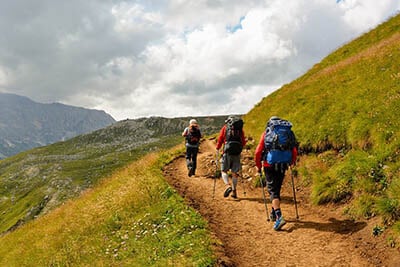
Alright, now that we combed through what hiking is, let’s take a look at trekking.
Although trekking is often used as a synonym for hiking, the effort involved with a traditional trek separates the two entirely.
Trekking involves a very strenuous effort, usually over the course of at least a couple of days. This requires hardcore trekkers to pack more gear, food, and water. It also calls for camping, most of the time (unless you’re an absolute monster who treks non-stop!)
Just like hiking, treks are completed in groups. However, you’re less likely to run into many fellow trekkers on your adventure, unless it’s a popular trekking path/trail.
With that in mind, always be sure to bring the proper supplies and take the best safety measures possible. You may be more likely to encounter wildlife, so always remember to respect wildlife and keep your distance; a selfie in front of a grizzly or wild cat really isn’t worth it, trust me.
What Gear Is Used For Trekking?

As with hiking, the type of trekking gear you choose will vary depending on weather conditions, terrain, and altitude.
What gear is used for trekking?
- Bigger backpack
- Camping gear like a basic tent, stove, and gas.
- Trekking poles
- Change of clothes
- Hiking Boots
- Steaks and Climbing gear (depending on terrain)
- Gaiters
- Weather-appropriate clothes
- Oxygen (if done at high enough altitudes)
- Maps & GPS Device
- Water Purification System
Depending on the distance of your trek and the location, some of the listed gear isn’t always required, though it’s still good practice to prepare properly.
You can expect your backpack to weigh more on a trek than it would during a hike, so proper packing is essential for your journey (we don’t want you gassed out halfway into it!)
What Terrain Is Involved In Trekking?
Trekking involves more intense inclines than hiking, for a longer period of time.
If you’re going for a trek, expect narrower paths and trails that are seldom marked for guidance.
Though inclines are usually more intense on a trek, don’t expect to scale up the rocky ridges of Everest—this isn’t mountaineering! Climbing gear isn’t typically required, though it may be needed at certain points.
The terrain of a trek is also more “wild”, meaning the paths chosen are typically more sprawling with shrubs and brush, making it difficult to search for a “defined” trail. This is where packing a good GPS for trekking comes in handy.
How Long Does Trekking Take?
Unlike hiking, trekking covers a lot of distance.
We’re not talking about a breezy 5-mile journey here. Completing a trek can take days.
Trekking vs Hiking: Which Works Best For You?
So you want to know if trekking or hiking is better for you. Well, I’m going to hit you with the golden, ever-vague answer:
It depends.
To best figure out if you should take up trekking or hiking, take a look at your goals and what you want to accomplish.
Trekking will, obviously, burn more calories and involves far more physical exertion depending on the terrain, so if you’ve mastered some hikes and are looking for a new challenge, trekking is a great choice.
It’s probably best to start small with a series of hikes that gradually build up in distance. That way, you can get used to bringing the right amount of gear and planning properly.
However, I don’t recommend trekking to someone who hasn’t completed a few hikes yet. Because of the longevity involved and careful planning needed for trekking, you need to make sure you’re bringing the right gear and supplies.
On the other hand, if you’ve completed some pretty intense hikes, it wouldn’t hurt to consider a small trek.
Use the same rules as you would with hiking: start small and build up from there.
Your well-being should always be the number one priority, so make sure you plan accordingly with whatever activity you choose.
Hiking vs Trekking: A Simplified Comparison
Did you take notes? No!? No worries. I’ve got a simple chart for you!
Trekking vs Hiking Comparison Chart:
| Category | Hiking | Trekking |
|---|---|---|
| Duration | Typically completed in a day | Can range from one-to-several days |
| Gear Required | A lightweight pack, hiking boots, pants, and clothing will do fine. | Trekking often requires more gear like poles, GPS, different types of clothing. |
| Difficulty Level | Hiking difficulty ranges from easy to difficult | Trekking is often more challenging to difficult |
| Terrain | Typical environments are hilly with marked and man | Steeper |
| Supplies Required | Depending on the trail, hiking can be done with just the essential supplies | Because of the duration and difficulty, trekking requires planning ahead. Consider water purifiers for extra water. |
| Physical Demands | Hiking ranges from easy to difficult in terms of physical activity | Trekking involves more rigorous activity, thus being challenging to difficult. |
| Price Points | Less gear can make hiking a little more affordable | Trekking requires more gear, thus can be a bit more pricey |
In conclusion, both hiking and trekking are great physical activities that will whip you into shape and give you the gratification of completing a goal.
Taking a hike or a trek is also a killer way to disconnect yourself from the noise of everyday life and better fully connect with yourself.
About The Author
Hey, I’m Mike, the guy behind Hike Authority. Hiking has literally changed my life and I wanted to share my expertise on hiking with the world.
Hike Authority
Hike Authority is your online guide to hiking info, tips, gear suggestions, and more. We strive to provide expertise and knowledge for hikers of all skill levels.
Navigation
Legal Disclaimer
Hike Authority is a participant in the Amazon Services LLC Associates Program, an affiliate advertising program designed to provide a means for sites to earn advertising fees by advertising and linking to Amazon.com.
Hiking vs Trekking: What’s the Difference?
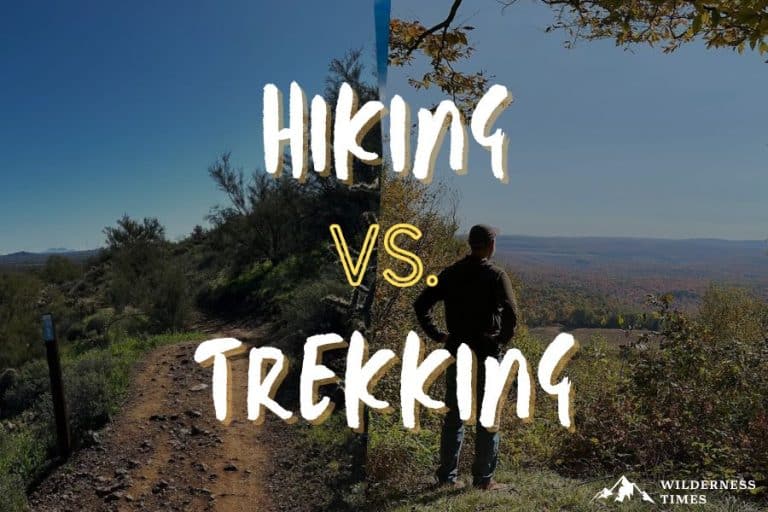
Wilderness Times may receive commissions for links included in articles to Amazon and other affiliate partners. We take pride in our testing and research, and recommendations are not given out lightly.
Picture this: You’re walking on the trail on a gorgeous day. You might ask yourself, “Am I hiking or trekking?”
And it’s a fair question! Seemingly similar, these commonly used terms can easily get confused.
In this article, we’ll take a look at the meanings of hiking and trekking, so you can know which “-ing” you’re doing out on the trail.
Hiking vs Trekking
Hiking can be defined as a form of outdoor recreation that involves walking on trails or in natural areas, such as forests, mountains, or wildernesses.
Hiking is a commonly used term among the outdoor recreation community.
In fact, most online creators who dabble in outdoor recreation use the term hiking to describe their activity of walking in the woods for leisure or exercise routines.
Most hiking is done either alone, or “solo,” or with a friend, family member, or group of other hikers.
The definition of trekking as a “long, arduous journey” emphasizes time more than activity.
Someone who is trekking is hiking longer distances, usually spanning more than one day of adventure travel.
This definition refers to longer and more strenuous hiking trips, where physical fitness, training, and hiking skills have to be top-notch.
For example, a hiker who is thru-hiking a longer trail could also use the word “trekking” to describe their journey.
A simple walk around a loop trail is a great example of hiking, while a multi-day hike through a wilderness area is a great example of trekking.
Hiking vs Trekking: Differences
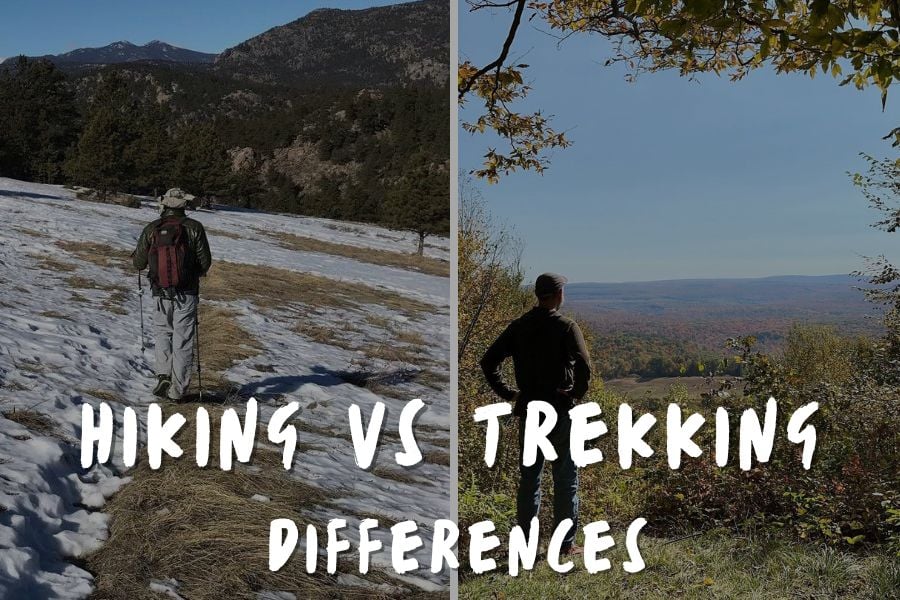
Let’s take a look at the differences between trekking vs hiking.
The main differences between hiking and trekking are the length of the trail, the duration spent outdoors, and the difficulty of your journey.
Hiking generally takes place on shorter trails during the daytime hours.
When I go for day hikes on the weekends, they might last four to six hours, depending on our speed and the sights on the trail.
However, if I were to set up camp on the trail for the night and continue down the path the following day, that definition would shift from hiking to trekking.
The time spent on the trail usually differs as well. Hiking as an activity usually ends on the same day the hike started.
Hikers usually hike somewhere to see something specific or get exercise but generally don’t stay overnight on the trail.
On the other hand, Trekkers typically plan for multi-day hikes, longer walking hours, and more intense exercise regimens.
The terrain and difficulty of hiking and trekking often differ as well. On hikes, the terrain is usually easier, and completing your trail isn’t as strenuous.
And, even if the hike is a little harder, it can usually be completed during daylight hours.
With trekking, you can expect the trail conditions to be more difficult, with rolling hills, roots, uneven trails, and other tougher obstacles in your path…
Logistics and navigation can also be easier for hiking than for trekking. Most hiking trails are marked and easy to follow, either on a map or on a hiking app, like All Trails.
In addition, many hiking trails are intuitive out-and-back or loop paths, making them easier to navigate without getting lost.
Trekking, on the other hand, is commonly done on moderate to rugged trails.
Many trekking trails may be poorly marked, and include old roadways, access trails, or longer trails often used for thru-hiking.
Hiking vs Trekking: Similarities
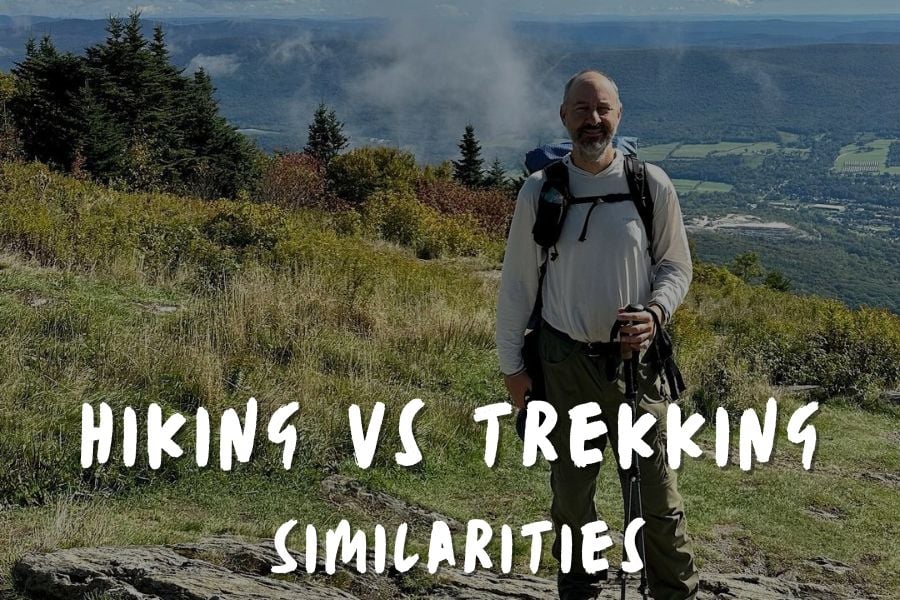
There are definitely similarities between hiking and trekking to take note of. Both activities are physical activities that allow you to connect with nature, go on adventures, and explore new areas – all while gaining immeasurable health benefits.
Both hiking and trekking are physical activities.
You can use both hiking and trekking as exercise routines that can help you get stronger and achieve your fitness goals.
However, because these activities are inherently physical, it’s important that you gradually work yourself up from shorter to longer hikes – and prevent any injury that may come from over-enthusiastic hiking or trekking activities!
Both hiking vs trekking allow you to connect with nature.
At their core, hiking and trekking get you out into nature and give you the opportunity to decompress away from your daily stressors.
Take the opportunity to breathe deeply – and maybe even learn more about native plants and birds!
Whether you’re taking a short hike or a longer trek, connecting with nature in this way can be great for your physical and mental health.
Both activities promote outdoor experience and adventure.
Going out on a hiking trail is an easy way to get an awesome outdoor experience. You can usually find trails of all different sizes and difficulty levels at state and national parks.
I commonly go hiking to explore new areas and go on historical adventures.
If I choose a shorter trail to hike, I’ll usually walk it to see the local plants and animals, including wildflowers, snakes, and other wildlife.
When I go trekking, I get to explore even more – and have even found old homesites and lightly trafficked views most people never get to see.
Trekking allows you to get off the beaten path and find even cooler views in the wilderness.
Both trekking and hiking have significant health benefits.
Hiking and trekking can be great activities to include in your fitness routine because they can be as strenuous (or not) as you want them to be.
This lets you be in charge of your fitness journey, and can lead to you becoming stronger and achieving wellness goals.
In addition to physical health, hiking and trekking have also been proven to improve mental health and help individuals cope with depression.
Getting away from the daily grind and into nature is good medicine for all of us.
Hiking vs Trekking: What should you choose as a beginner?
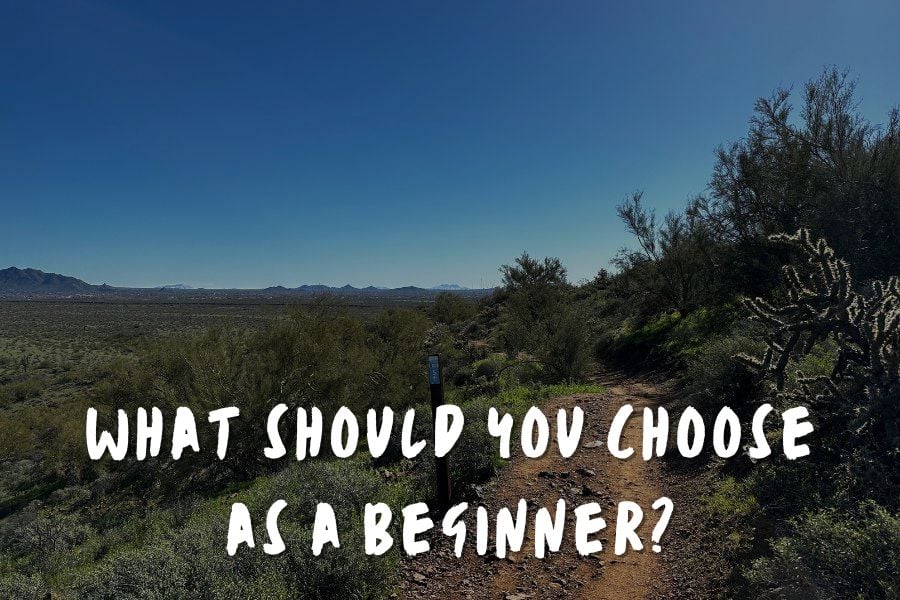
I always recommend beginners try day hikes to test the waters before they jump into the “deep end” of a trek. Why? Well, hiking is easier and will help you develop your competence and confidence in the outdoors..
And, because hiking and trekking can be taxing on your body and muscles, it’s better to start small and build yourself up to longer hikes – and eventually, epic treks!
For a step-by-step, it’s best to start out with easier hiking trails, move onto moderate hikes, and gradually get into the trekking world.. This way, you won’t injure yourself by going too far, too fast.
Day Hiking vs Multi-Day Trekking: A Comparison
There are comparisons between day hiking and multi-day hiking to consider.
Day hiking and multi-day hiking are both a form of hiking but have different functions.
Day hikes tend to last a few hours, while multi-day hikes could last a few days, weeks, or even months, pending on how long the trails and planned trips are.
Both types of hiking require specific gear and equipment. But day hiking typically requires less gear than multi-day hiking.
You’ll need a camp kitchen with extra food and water when you hike for more than one day.
You need a backpacking tent and other sleeping supplies from a sleeping bag to a mattress pad and a backpacking pillow.
You typically don’t need the extra gear when you’re just going for a simple day hike.
Planning for a day hike takes less effort than planning for a multi-day hike.
You can usually check the weather, dress for it, and use your map or app to get through the day.
You must account for each day on a multi-day hike, and planning can become much more extensive.
And lastly, multi-day hiking requires more physical strength, fitness, and comfort levels than regular hiking.
Most anyone can go day hiking.
You choose a trail based on your difficulty level, and you can gradually increase it by choosing harder trails as you progress.
But with multi-day hiking, you’re putting more strain on your body and experiencing harder activities.
Hiking is easy and can be improved more efficiently, but multi-day hiking can be very adventurous.
Hiking vs Trekking: The Gear You Need
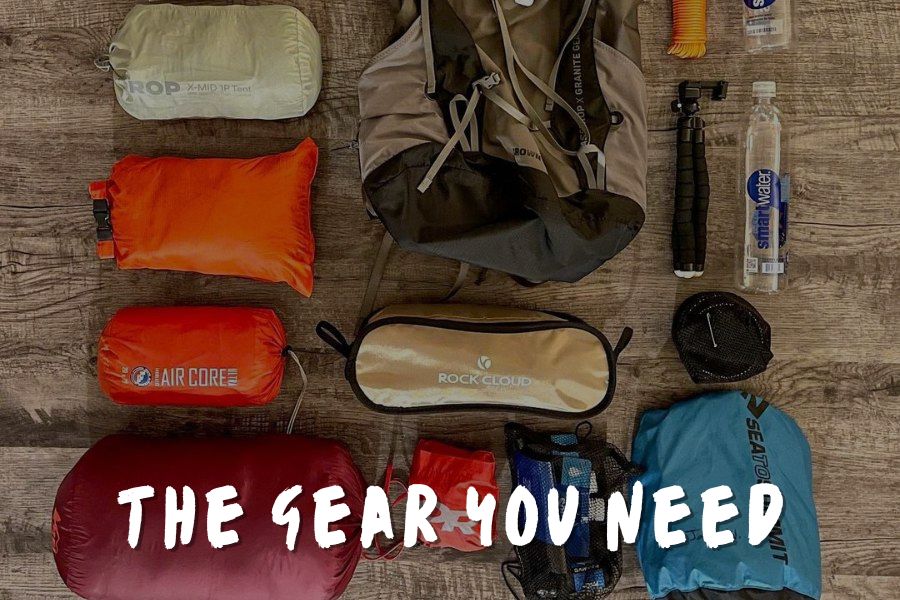
As we’ve covered earlier in the article, there’s a difference between hiking and trekking in the amount of time you’re spending on the trail.
Because of this, there is a difference between the type and amount of gear you need to take with you when you’re doing each activity.
When you’re hiking, you’ll just need gear for the day. This includes water, snacks, a first aid kit, a flashlight, and a bandana.
For clothing, all you’ll need is hiking boots, a rain jacket, and maybe trekking poles to help with the tougher sections of the trail.
However, for a trekking or multi-day hiking trip, you’ll need all of the above and more to keep you geared up and prepared.
Because of this, expect to have a bigger backpack that can hold more gear, including your food, water, tent, sleeping bag and more.
Depending on how long you’re trekking for, you may also need to bring kitchen items, including water filtration, pots, and a portable stove.
Basically, the longer you plan to stay out in the wild, the more gear you may need to bring with you.
Hiking vs Trekking: Safety Tips
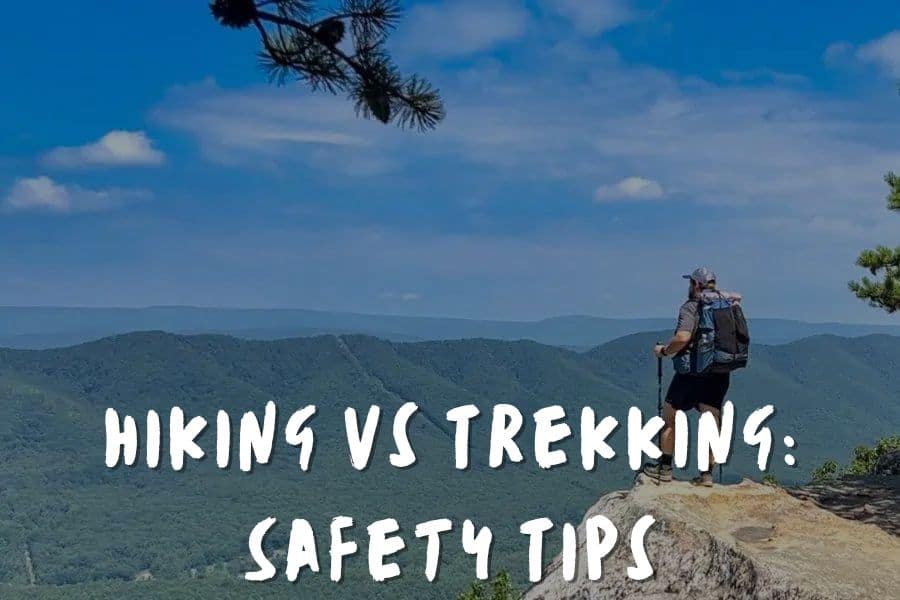
Let’s go over safety tips for hiking and trekking! Common sense can go a long way, but there are some specific tips that can help you get started.
First up, logistics. A safe outdoors person is one that plans.
Make sure you know which trail you’re going on and how long you’re going to be on the trail for. Then, plan your gear and pacing accordingly.
You should always tell someone what trail you’re going on, when you plan to return, and who you’re hiking or trekking with.
It’s also important to review your trail before you head out on your hiking or trekking adventure.
Make sure you have a map (or picture of a map) and feel comfortable navigating to your destination.
Trekking usually requires more advanced land navigation skills, like reading a topography (topo) map or using a compass.
However, if you want to level up your hiking competencies, bring a topo map or compass on your day hiking trips to practice your skills!
Like I mentioned in the section above, a longer hike may require more gear, so be sure to bring what you need for the duration of your trip.
For both hiking and trekking, always bring a first aid kit and a way to contact the “real world” (e.i., locator beacon or whistle) in case of an emergency.
Next, make sure you’re aware of the potential environmental and wildlife-related risks prevalent in the area, especially considering any wildlife that may share the area with you.
For example, when you are trekking in wilderness areas, you might encounter bigger predator animals, such as bears, mountain lions, and wolves.
Activity levels for these animals can vary depending on the time of day and season of the year, so do your research and take preventative measures (e.i., pack bear spray, and make regular loud noises) to stay safe.
Remember that this is their home, and you’re just visiting!
Finally, stay hydrated and fueled – and know your limits! Be sure to drink plenty of water and eat plenty of carb-loaded foods and snacks to keep yourself fueled on the trail.
And, make sure you pace yourself and understand what physical activities you can and can’t do so you can keep yourself and others safe.
Follow these tips and, most importantly, use your common sense, to keep yourself safe while hiking and trekking.
FAQs
Read on to learn more about some of the common frequently asked questions concerning hiking and trekking.
What is the biggest difference between hiking and trekking?
The biggest differences between hiking and trekking are the difficulty of the trail and the time spent on the trail itself.
Hiking is usually easier and done within one day during the daylight hours.
Trekking is usually done on more difficult terrain and typically lasts more than one day.
Is hiking shorter than trekking?
Usually, yes. Hiking is typically done on loop or out-and-back trails that only take a few l hours to complete.
Trekking, on the other hand, is typically done on longer trails that require multiple days, weeks, or even months to complete.
Some people will even trek worldwide, which can take them multiple years.
What types of terrain are typically encountered while hiking vs trekking?
When hiking, most people encounter easier to moderate terrains with some roots, rolling hills, or uneven surfaces. However, most of the time, hiking trails are fairly easy to follow.
Trekking trail conditions typically range from moderate to very rugged. Most trekkers can expect significant elevation gains, mountainous regions, and rough trails that can be more difficult to follow.
What distance is considered a hike?
In most cases, a day hike’s distance will range from less than a mile to one to eight miles.
This range is about as many miles as a person can hike in one day without worrying about not being back to their starting point before nightfall.
This gives hikers plenty of time to stop and look at sites along the trail, take photos, and enjoy the natural surroundings they encounter.
What distance is considered trekking?
Trekking is typically longer than hiking.
You can usually expect trekkers to hike ten to twenty miles a day or within a few days.
Many thru-hikers will try to cover as much ground as they can each day and will plan rest days to rest and recover.
Because trekkers are focused on covering more miles in a day, they tend to enjoy the natural sites on the way and travel faster with fewer stops.
Conclusion
While similar, hiking and trekking largely differ in the length and difficulty of your outdoor adventure.
However, both activities will get you into nature to have a great adventure in the outdoors!
Hiking and trekking saved my life and have made me healthier each time I do them.
Shawn Gossman is known as Hiking With Shawn in his local area. A longtime hiker, cyclist, and mountain biker turned into a local social media influencer. Shawn is a permitted hiking guide for the Shawnee National Forest and an outdoor writer. Shawn lives in the very bottom of the state of Illinois with his girlfriend, her teenage daughter, and a bunch of cats.
https://hikeauthority.com/hiking-vs-trekking/https://wildernesstimes.com/hiking-vs-trekking/
